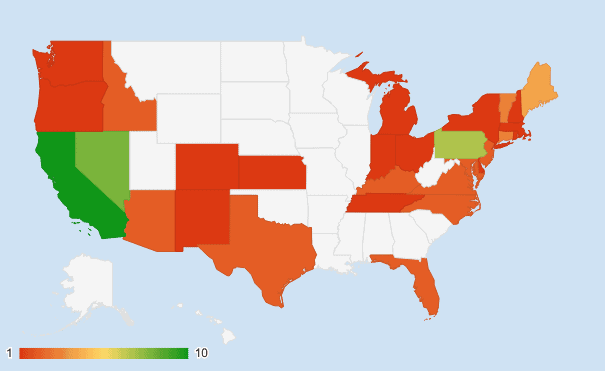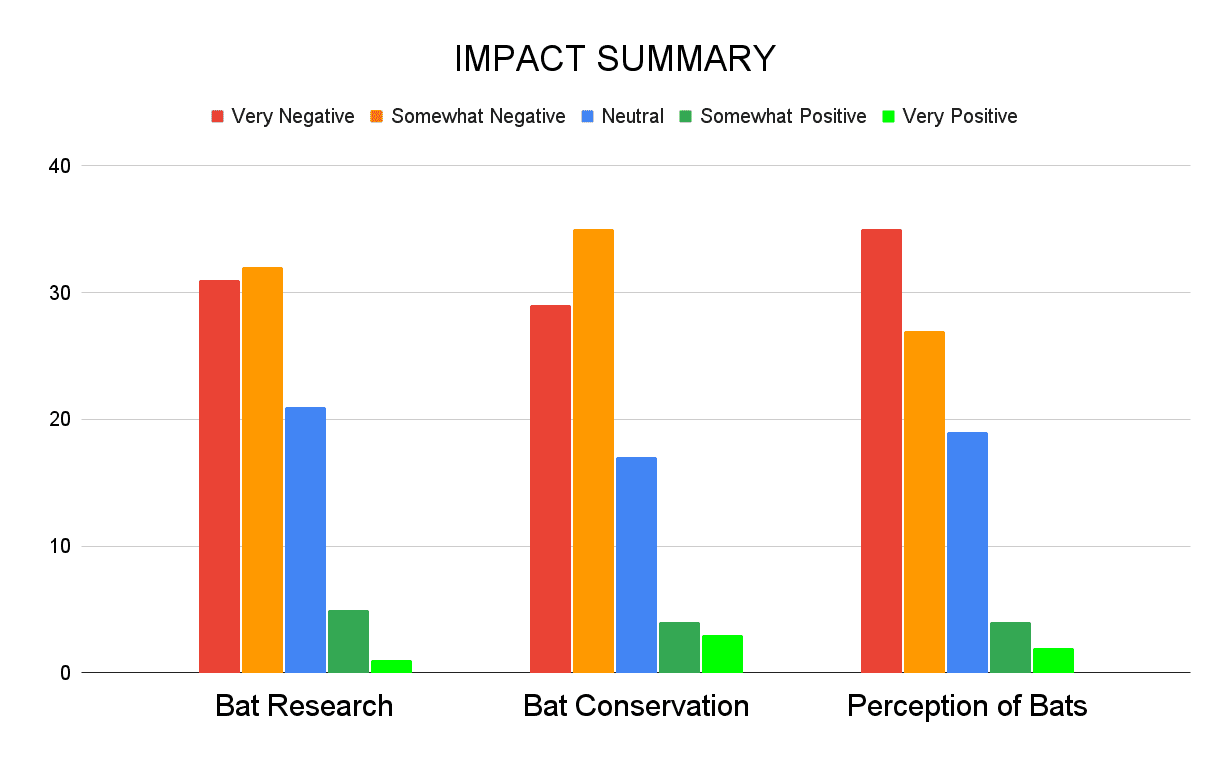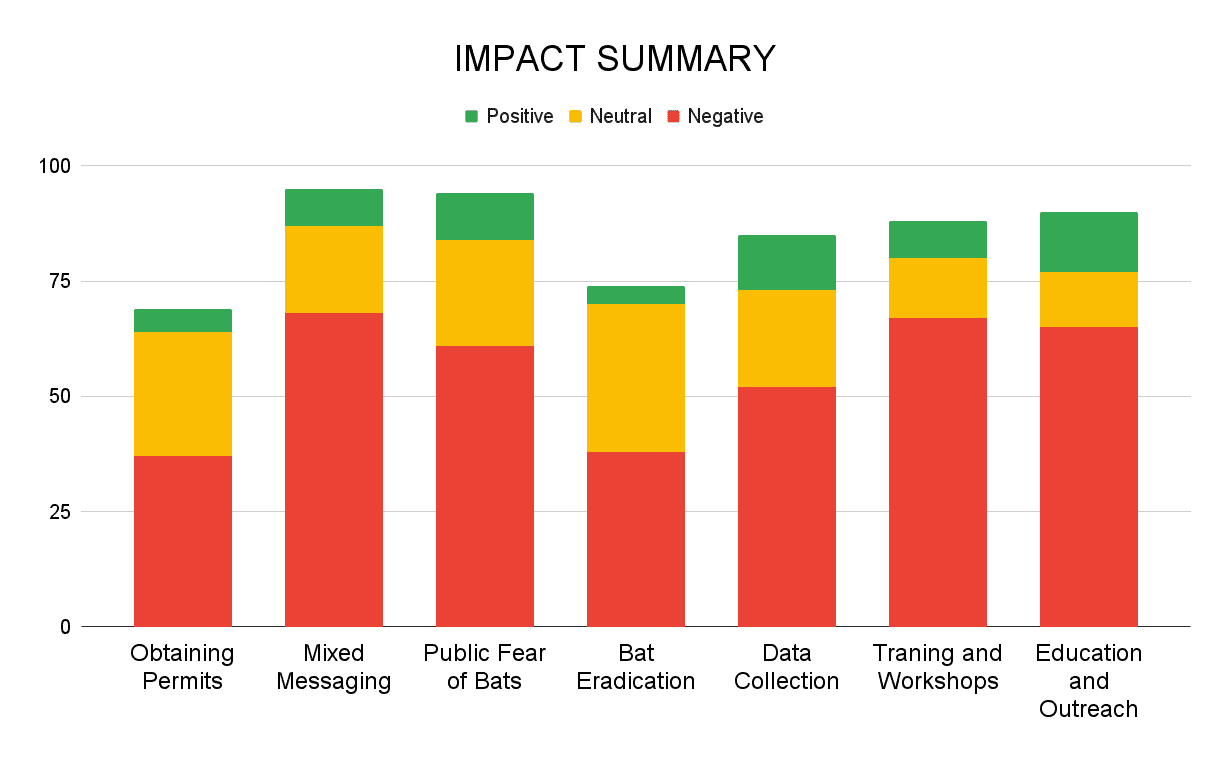Many who work with bats have been impacted by efforts to prevent the spread of COVID-19 from humans. We circulated the following opinion survey to better understand their views. Survey objectivity is notoriously difficult to achieve, but we have attempted to cover the full range of opinions provided.
Methods and Limitations
We digitally distributed our survey globally, on March 17, 2021. Through today, we have received 96 responses from professional bat workers in 29 U.S. states and 13 additional countries. Seventy-five percent of respondents were biologists involved in bat research or management, and 25% were bat rehabilitators and educators who interact with the public. Occupational differences resulted in the removal of “Not Applicable” responses. Confidentiality was promised, but some reportedly abstained for fear of negative impacts from reviewers of permits or grants. Quoted respondents gave permission. Results are limited to those who chose to report and by the completeness of their reports.
Reported Restrictions
Most countries are attempting to follow IUCN guidelines, but interpretations vary widely. Some require no restrictions, while others prohibit any bat work that includes close association with bats. In practice, reported restrictions often mean a complete cessation of research, training workshops, and/or rehabilitation.
Opinions
- 66% reported negative effects on their research, 32% very negative.
- 67% reported negative effects on conservation, 30% very negative.
- 65% reported negative effects on the perception of bats, 37% very negative.
- 54% reported increased difficulty in obtaining research or education permits.
- 61% reported decreased data collection.
- 76% reported reduced training workshop opportunities.
- 72% reported reduced public education.
- 88% reported increased mixed messaging to the public.
- 65% reported increased public fear of bats.
- 51% reported increased bat eradication attempts.
- 85% believed that restrictions are less than fully effective, 15% very effective.
Comments From Responders
Responders from several U.S. states reported increased intolerance of bats roosting in buildings, and some even cited euthanization of non-listed species accidentally captured during field studies. We found a wide range of opinions over the effectiveness of current restrictions, but most expressed confidence in the potential for safely returning to work.
There was also widespread frustration with inconsistent interpretations of what are “essential” versus “non-essential” activities and restrictions preventing work with non-listed species. Modifications to IUCN guidelines were announced on July 2, 2021. They included new instructions on assessing risk, clearly attempting to facilitate a return to work. Nevertheless, responders continued to report problems with government agencies due to subjective, often overly conservative, permitting decisions that hamper progress.
Interpreting Results
Survey responses revealed several unintended consequences of restrictions. Respondents reported a sharp decrease in conservation-relevant research, public education, and key training workshops for professionals, at a time when they are most needed. North Americans reported the most stringently enforced restrictions – in part due to continued enforcement of failed efforts to stop the advance of the fungus that causes white-nose syndrome (WNS). The following quotes are representative of the most frequently written responses.
“With the potential listing of bat species due to the impact of WNS, biologists in the state are falling behind on inventory and monitoring. This will negatively impact the baseline data available if/when species are added to the ESA [Endangered Species Act]. Large scale bat capture efforts, including training and workshops, within Nevada have been cancelled for 2020 and 2021.”
–Anonymous, Wildlife Biologist, NV, USA
“I’ve observed the following: (1) increased use of acoustics as a sole survey method to document bat presence, when for many species identification can only be done with a bat in the hand; (2) decreased hands-on training opportunities needed for furthering on-going bat survey objectives; and (3) increased animosity towards permitting agencies and departments of health due to their seemingly capricious decisions that single-out researchers and educators as possible vectors of COVID transmission to bats while ignoring the more expansive numbers of the general public who interact with bats on a daily basis.”
–Janet Tyburec, Workshop Trainer & Environmental Consultant, AZ, USA
Eighty-five percent of respondents doubted that restrictions on professional bat workers could be fully effective in preventing COVID exposures from humans to bats. However, a wide range of opinions were reported.
“I would like to see a reinstatement of all permits for research, inventory, and monitoring activities. While I personally don’t think it is necessary, I would be amenable to adding additional levels of PPE, such as masks and vaccinations, if it meant being able to resume bat work.”
–Anonymous, Government Agency, USA
“Handling by vaccinated people with sensible restrictions, such as masks, gloves, and avoiding bat work when sick, should be required. If these conditions are met, bat handling should not be restricted.”
–Bryan Hamilton, Government Agency, CA, USA
“Now we have one set of rules for researchers (the ones likely to take all precautions) and no rules for the public. It makes no sense.”
–Todd Stefanic, Government Agency, ID, USA
An unprecedented resurgence of public intolerance of bats was reported. Some U.S. states were even identified as requiring extermination of bat colonies living in buildings. Historically, people who fear bats have killed thousands, even millions, in single incidents.1,2 Seventy-one percent of respondents shared concerns regarding the impact of mixed messaging as a threat to bat conservation. Visual images of researchers donning full PPE when approaching bats risk reversing decades of educational progress in overcoming irrational fear of bats as vectors for disease.
“Handling bats with PPE in front of local communities, even if meant to protect the bat, can trigger fear and misconceptions of bats.”
–Natalie Weber, Wildlife Biologist, Germany
A recent survey conducted by Tigga Kingston examined community perceptions of bats since COVID-19. The results revealed strikingly similar themes. Participants from across 39 countries overwhelmingly cited “Fieldwork and Monitoring Restrictions” as the greatest negative impacts, closely followed by “Misinformation” and “Persecution [of bats]”.3 Fear of bats was reported to be growing, despite increased efforts to combat negative messaging and misinformation. Participants submitted no solutions on how to address persecution, clearly highlighting the need to put fears in perspective.
In our opinion, bats will continue to suffer from growing public fear for as long as they are defended, only because they are essential, while still being presented as uniquely dangerous sources of disease. When communicating with the general public, special efforts should be made to minimize any implication of bats being dangerous sources of disease and to clarify that PPE is needed to protect against human transmission of COVID-19.
Questions to Consider
1. Can we prevent transmission of COVID to wildlife?
Humans appear able to transmit COVID to a wide variety of other mammals, from mice to deer, and even domestic cats and livestock, with little harm.4,5 COVID antibodies were recently discovered in 40% of white-tailed deer across four U.S. states. As with other non-primate mammals, they showed few, if any, signs of illness, and may already be spreading it to other species.6 Hunters were simply advised to follow normal procedures for safe processing and were quickly reassured that “Based on the available information, the risk of animals spreading COVID-19 to people is low.”7
In sharp contrast, we are often warned of grave risks of COVID transmission either to or from bats. The apparent bias is reminiscent of rabies warnings that focused disproportionately on bats in the 1970s and 80s, making bat conservation nearly impossible.1,2
2. Why are COVID restrictions uniquely focused on bat workers when rapid spread among other wildlife already appears to be beyond our control?
We can’t control the public’s interactions with bats. Thousands of people worldwide encounter bats that enter their homes, and additional thousands contact them while exploring caves. Countless more hunt bats for food or medicinal use.1 Most are not even aware of restrictions applied to professional bat workers. Their numbers dwarf those of professional bat workers.
This raises another important question:
3. Can wildlife exposure to COVID be prevented, and is the apparently low potential for success worth the cost?
References
- Tuttle, M. D. Threats to bats and educational challenges in Bat Evolution, Ecology, and Conservation 363–391 (2013). doi:10.1007/978-1-4614-7397-8_18.
- Tuttle, M. D. Fear of Bats and its Consequences. Journal of Bat Research & Conservation 10, (2017).
- Rutrough, A., Kingston, T. & Tsang, S. M. Scientific perceptions of bat conservation and COVID-19: Insights from the International Berlin Bat Meeting 2021. GBatNet https://gbatnet.blogspot.com/2021/10/scientific-perceptions-of-bat.html (2021).
- Cohen, J. The hunt for SARS-CoV-2’s ancestors heats up. Science 373, 1076–1077 (2021).
- Fagre, A. et al. SARS-CoV-2 infection, neuropathogenesis and transmission among deer mice: Implications for spillback to New World rodents. PLOS Pathogens 17, e1009585 (2021).
- Chandler, J. C. et al. SARS-CoV-2 exposure in wild white-tailed deer (Odocoileus virginianus). bioRxiv 2021.07.29.454326 (2021) doi:10.1101/2021.07.29.454326.
- Murray, J. White-tailed deer can get COVID. Here’s what hunters need to know. Press Connects https://www.pressconnects.com/story/news/local/2021/09/28/white-tail-deer-covid-positive-new-york-hunters-safely-eat-meat/5815817001/ (2021).




